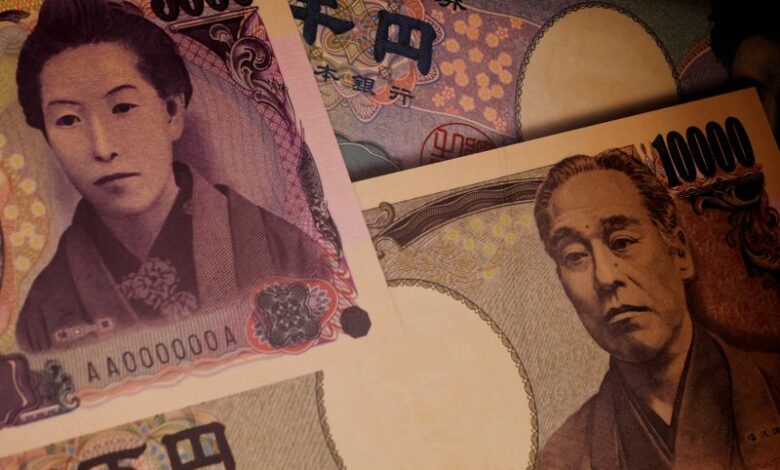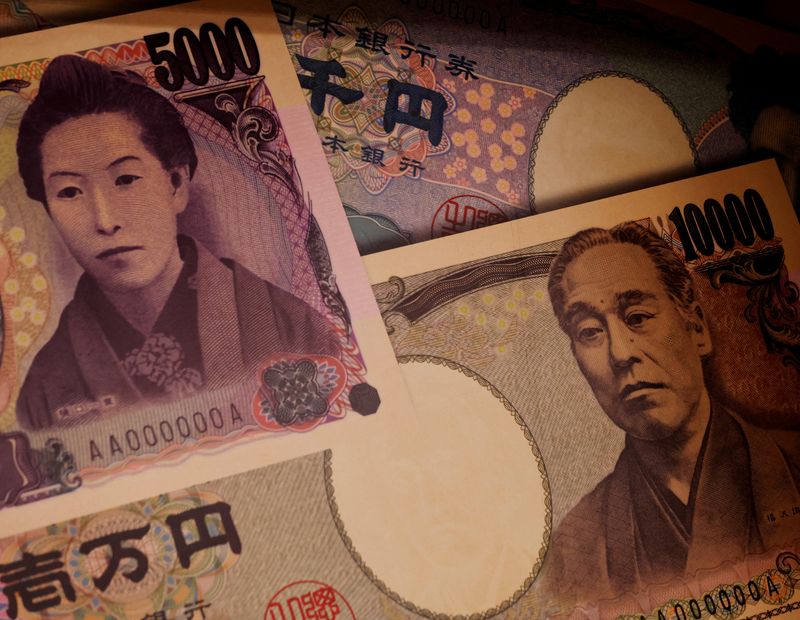Funds maintain large short yen position ahead of BOJ decision: McGeever


© Reuters. FILE PHOTO: Examples of Japanese yen banknotes are displayed at a factory of the National Printing Bureau producing Bank of Japan notes at a media event about a new series of banknotes scheduled to be introduced in 2024, in Tokyo, Japan, November 21, 2022
By Jamie McGeever
ORLANDO, Florida (Reuters) -Hedge funds have cut back their huge bet against the yen ahead of the Bank of Japan’s policy decision on Tuesday, but not by much, suggesting they don’t believe a landmark interest rate hike would do much to improve the currency’s immediate fortunes.
The BOJ is expected to deliver its first rate hike in 17 years on Tuesday, bringing the curtain down on eight years of negative interest rate policy (NIRP), and the latest move to end decades of deflation-fighting, accommodative policy.
As historic as that would be, however, it probably won’t move the dial much for currency traders unless it is followed up with further action, and unless the yen’s yield gap with other currencies like the dollar shrinks significantly.
More clarity on that will no doubt come from BOJ Governor Kazuo Ueda on Tuesday, and the U.S. Federal Reserve in its policy statement and Fed Chair Jerome Powell in his press conference on Wednesday.
But until then, the jury is out and speculators are reluctant to buy into the view that Japan’s first baby step into the world of policy normalization is a game-changer for the yen.
The latest Commodity Futures Trading Commission data show that funds cut their net short yen position by 16,521 contracts to 102,322 contracts in the week ending March 12.
That follows a reduction of almost 14,000 contracts in the prior week, marking the first time this year funds have scaled back their bearish yen bets two weeks in a row.
A short position is essentially a wager that an asset’s price will fall, and a long position is a bet it will rise. Hedge funds often take directional bets on currencies, hoping to get on the right side of long-term trends.
These figures show that funds have cut their yen position by around 20% from what was the largest net short in more than six years at the end of February. At almost 133,000 contracts, it was one of the most bearish yen bets on record.
In dollar terms, the latest position roughly equates to a $8.65 billion leveraged bet on the yen weakening. That’s still large by historical standards, so there is room to reduce that further and put upward pressure on the yen.
But that will need a catalyst.
Given how historic a Japanese rate hike would be, it is reasonable to assume BOJ policymakers will want to proceed cautiously. The fact that only 25 basis points of tightening this year is priced into Japanese swaps attests to that.
The U.S. rate outlook, meanwhile, appears to be moving in the dollar’s favor. The amount of Fed policy rate easing expected by markets this year continues to be trimmed back, which helps explain why dollar/yen is closer to 150.00 than 145.00.
Given how closely dollar/yen has correlated this year with the spread between two-year U.S. and Japanese yields, the yen might need a substantial narrowing in the spread to get any real momentum behind it.
“Every delay in the market’s expectation for the Fed to start the cutting cycle ended up with pressure on the yen and 10-year JGB (Japanese Government Bond) yields,” analysts at Natixis wrote in a client note this past weekend.
Morgan Stanley analysts note that a “soft landing” and only gradual U.S. rate cuts continue to be the market’s default position, while expectations for the BOJ over the next 12 months haven’t actually changed that much recently.
“This in turn implies that the prospective US-Japan policy trajectory should be little changed, suggesting … should continue to perform reasonably resiliently,” they wrote on Sunday.
The yen goes into the BOJ meeting as the worst-performing major currency this year. Funds are taking some chips off the table but are still betting that U.S.-Japan rate and yield spreads will stay wide, to the detriment of the yen.
(The opinions expressed here are those of the author, a columnist for Reuters.)
(By Jamie McGeever; Editing by Paul Simao)



